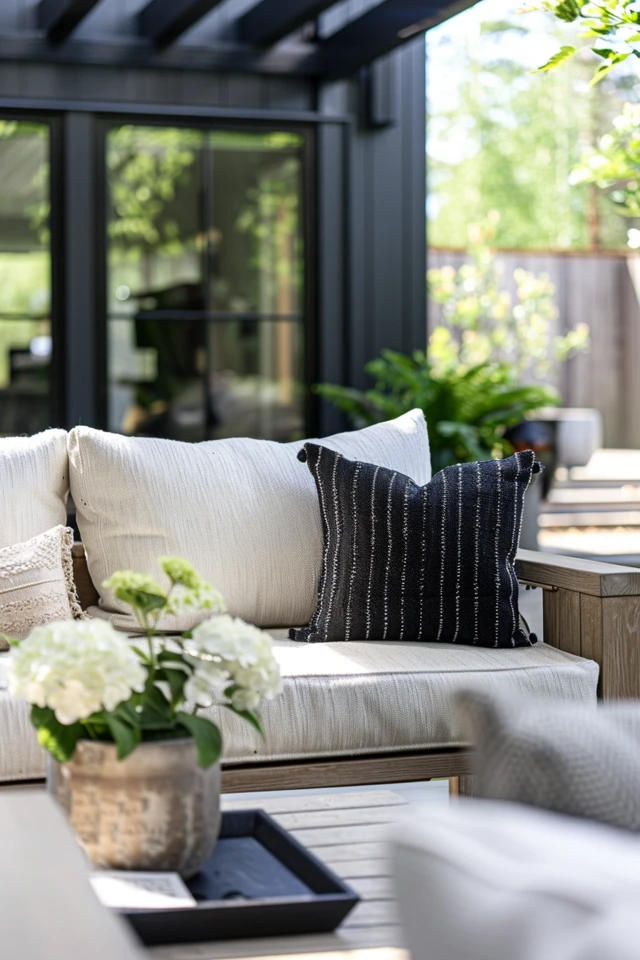When it comes to designing outdoor living spaces, creating seamless transitions is key. This is especially true when transitioning from a deck to a patio. By carefully planning the layout and incorporating thoughtful design elements, you can ensure a smooth flow between these outdoor areas.
One important aspect to consider is the use of wide, gently sloping levels. This not only makes the transition safer but also more inviting. Incorporating wide stairs or ramps can help connect the deck and patio, making it easy for everyone to move between the two areas.
Another way to create a seamless transition is by introducing multiple levels in between the deck and patio. This can be done by using different flooring materials, such as stepping stones or wooden platforms. These intermediate levels not only add visual interest but also make the transition feel more natural.
In terms of aesthetics, incorporating similar elements in both the deck and patio areas can help create a cohesive look. Choose furniture, lighting fixtures, and plants that are complementary in both spaces. This will visually connect the two areas and ensure a seamless transition.

Color also plays a crucial role in creating a seamless deck to patio transition. Consider painting or staining the surfaces of both areas to match each other. This simple step can make a significant difference and make the transition seem effortless.
By carefully planning and paying attention to the details, you can create a deck to patio transition that enhances your outdoor living experience. Now let’s explore some key takeaways for creating seamless outdoor spaces.
Key Takeaways:
- Design wide, gently sloping levels for a safe and inviting transition from the deck to the patio.
- Incorporate wide stairs or ramps to seamlessly connect the two areas.
- Create multiple levels in between the deck and patio for a natural flow.
- Choose furniture, lighting, and plants that are complementary in both spaces for a cohesive look.
- Consider painting or staining surfaces to match and create a seamless visual transition.
Tips for Planning the Transition from Indoor to Outdoor Spaces
When it comes to designing seamless transitions between indoor and outdoor spaces, careful planning is key. Assessing the layout of both areas and identifying potential obstacles will help ensure a smooth flow between them. Consider incorporating furniture and decor that can seamlessly transition between indoor and outdoor environments, creating a cohesive aesthetic that blurs the boundaries between the two spaces. With a creative deck layout and thoughtful patio design, you can enhance the overall appeal of your backyard renovation.

When evaluating your floor plan, look for opportunities to establish indoor-outdoor rooms that seamlessly connect the interior and exterior spaces. By extending the same design elements and color schemes from indoors to outdoors, you create a harmonious transition that invites relaxation and enjoyment. Paying attention to transition points, such as doors and windows, allows you to modify them in a way that enhances the connection between the indoor and outdoor areas.
Bringing the Outdoors In
One way to seamlessly transition from indoor to outdoor spaces is by incorporating landscaping elements along the path. This not only adds visual interest but also emphasizes the connection between the two areas. Consider using planters, potted plants, or even a small garden bed to create a natural transition zone. With the right patio design trends, you can transform your outdoor space into an extension of your indoor living area, providing a seamless flow between the two.
“A well-designed transition from indoor to outdoor spaces creates a harmonious flow and enhances the overall experience of your home.”
Inspiration for backyard renovation can come from various sources. Look for ideas in home improvement magazines or online platforms where you can find creative deck layout examples and patio design trends. Take note of the materials, colors, and layouts that catch your eye and align with your personal style. Remember, attention to detail during the planning phase will help ensure a successful transition from indoor to outdoor spaces.

Enhancing Connectivity Between Indoor and Outdoor Spaces
To enhance the connectivity between indoor and outdoor spaces, consider installing large windows or glass doors that provide an unobstructed view of the outdoors. This brings in natural light and blurs the boundaries between the two spaces.
Select furniture and decor that can be used in both indoor and outdoor environments to create a seamless transition. Investing in versatile pieces that can withstand different weather conditions will ensure a cohesive look throughout your indoor and outdoor spaces.
Incorporate technology, such as outdoor speakers or a weatherproof television, to add an element of entertainment that can be enjoyed in both spaces. This will allow you to create a unified entertainment experience, whether you’re inside or outside your home.
Maximizing natural light, extending color schemes and textures, and utilizing visual cues and flow patterns are practical tips for creating a seamless transition. By carefully considering these factors, you can create a harmonious flow between your indoor and outdoor living spaces, enhancing your overall living experience.

